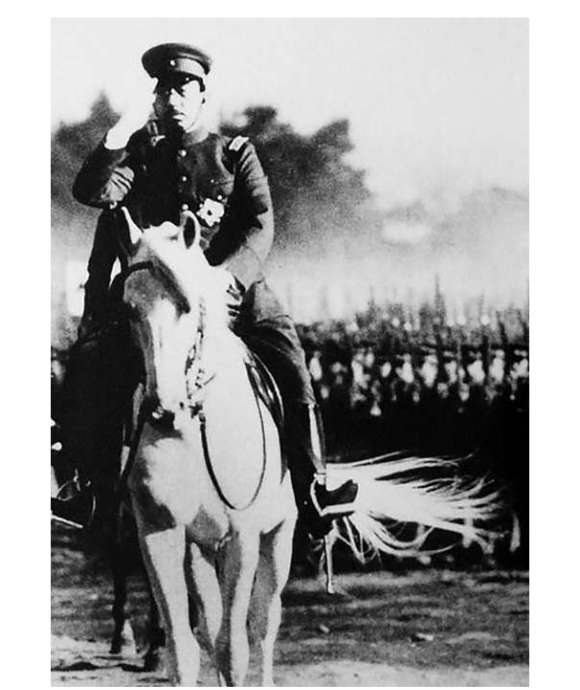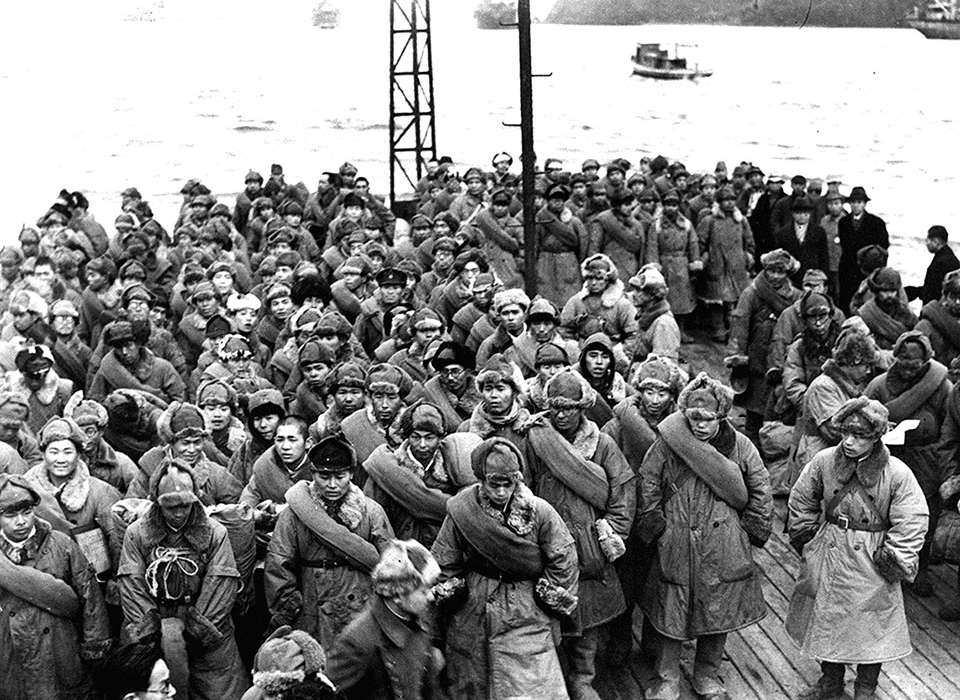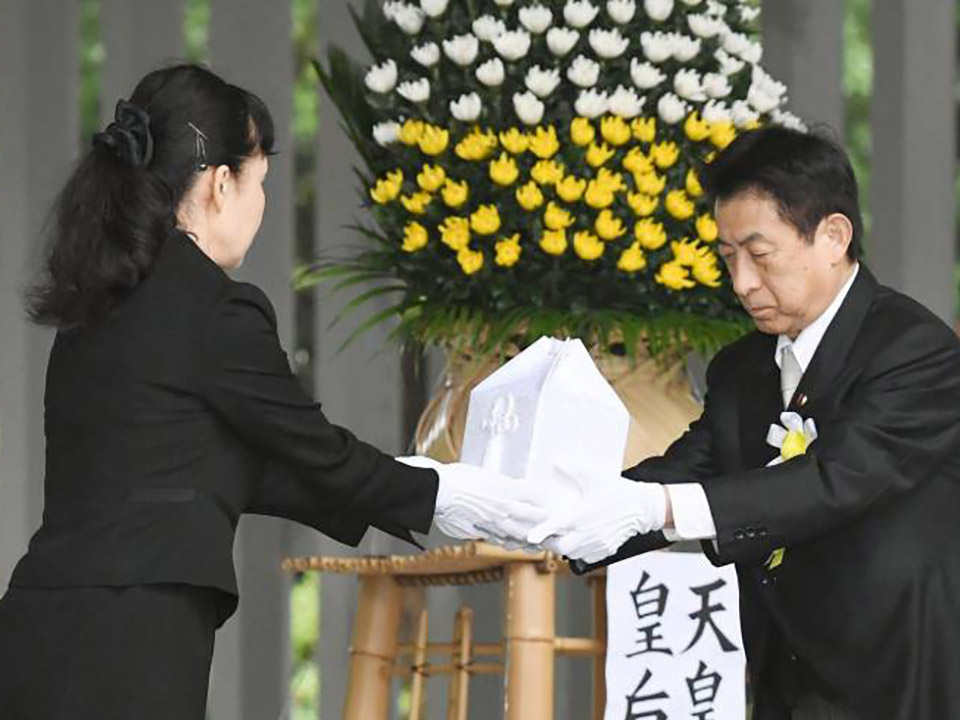Top Image: Japanese soldiers returned from a Soviet POW camp in Siberia. Maizuru, Japan, 1946. Source: Japan Times, Unknown Author.
Beneath the waves of the Pacific Ocean and under the soil of the lands which border it lies one of the starkest reminders of Japanese imperialism: the remains of some one million soldiers, sailors, marines, and airmen of Imperial Japan’s armed forces who perished in World War II. Perhaps half of them are potentially recoverable. By comparison the United States has some 72,000 unrecovered service members from World War II in all theaters of the conflict combined, with about 26,000 deemed recoverable by the Defense POW/MIA Accounting Agency (DPAA).
Tens of thousands of these nearly forgotten Japanese dead had once been prisoners of war in Soviet captivity, seized in the global conflict’s final weeks. On August 8, 1945, Joseph Stalin, keeping his promise to Franklin D. Roosevelt and Winston Churchill at Yalta the previous February to intervene 90 days after Germany surrendered, declared war on Japan. Right into early August, Japanese officials clung to the hope that the Soviets might negotiate a peace deal with the Western Allies. That hope dissipated in the lightning advance of the Red Army launched on August 9.
Named the Manchurian Strategic Offensive Operation but better known now as “August Storm,” a term popularized by historian David Glantz, it was a gargantuan undertaking coordinating air, sea, and land forces. Soviet troops, 1.5 million of them commanded by Marshal Aleksandr Vasilevsky, steamrolled into Manchuria and, subsequently, conducted amphibious operations on southern Sakhalin Island, in northern Korea, and on the Kurile Islands. Faced with this onslaught, the Japanese Kwantung Army, along with its Manchurian and Mongolian auxiliaries, surrendered. After initial resistance, Japan’s forces on the Korean peninsula, Sakhalin, and the Kuriles also laid down their arms to the Soviets.
The number who surrendered in the weeks after August 9 is astounding—between 1.6 and 1.7 million men. This was just under half of the 3.5 million Japanese combatants left abandoned outside of Japan when Emperor Hirohito announced his country’s acceptance of Allied terms. Thousands of Japanese civilians, as well as Koreans and Manchurians, were also rounded up. Similar to the atrocities they perpetrated in Germany, Austria, and Hungary earlier in the year, the Red Army sullied their triumph by engaging in mass rape and systematic pillage against the populations of these newly occupied areas.
That the Japanese gave up in such incredible numbers seemed miraculous at the time. The indoctrination these men had undergone in Japanese military culture taught them to prefer death to surrender. American experiences on Tarawa, Saipan, Iwo Jima, Okinawa, and other islands, where so few Japanese surrendered, cemented the expectation that the armed forces of Japan, if not the civilian population, would fight bitterly to the very end if the country were invaded. Soviet forces encountered a very different enemy, though. By August 1945, war weariness, overwhelming odds, and sheer self-preservation exerted countervailing pressures to the indoctrination. While they did fight hard at the outset of August Storm, Japanese soldiers eventually capitulated in droves to the Soviets. What lay ahead for them in Siberia was long and dreadful.
Processing and sustaining such a massive array of prisoners would have been a daunting task for any military. Still, the Soviets inflicted terrible brutality on their Japanese captives. A labor shortage meant that these prisoners of war could expect arduous toil. They did so in a completely foreign, Siberian environment and climate that was merciless. Food, or the lack of it, and the elements worked against the men. Like Imperial Japan, the USSR had not signed the Geneva Conventions of 1929 regulating the treatment of POWs. That, however, was not the only reason why Soviet personnel often acted so cruelly. First, there was the history of the Russo-Japanese War, then the Japanese government’s intervention in Siberia against Lenin, Trotsky, and the Bolsheviks during the Russian Civil War. The confrontation stemming from border disputes between the Soviet Union, Japan’s puppet state in Manchuria and Mongolia, culminating in the 1939 Nomonhan Incident, had not faded from memory. Perhaps, too, the discovery in the city of Harbin of gruesome medical experiments carried out on 3,000 Chinese and Korean civilians by the Japanese Army’s chemical and biological warfare division, the notorious Unit 731, fueled a desire for revenge. The best explanation, however, is that the Stalin regime treated its enemies, external and internal, ruthlessly.
Starting in late 1946 the USSR began to repatriate the POWs, freeing 625,000 in the following year alone. The Stalin regime declared in the spring of 1949 that just 95,000 Japanese prisoners remained in Siberia and they would be sent home by year’s end (many would not actually return until well into the 1950s.) As John Dower describes, this announcement led to enormous confusion in Japan. If earlier documentation was truly reliable, the actual number of POWs should have been closer to 300,000. What happened to these men and where were their remains? In the early 1990s, after the Cold War ended, Russian authorities published the names of 46,000 Japanese who had died in the Soviet prison camps. Vanderbilt University historian Yoshikuni Igarashi more than doubled that number, estimating that 100,000 Japanese captives perished in the Soviet camps.
Many of these returnees did not stay silent after they resettled into life in Japan. Largely unknown in the United States, a memoir literature about life in the Soviet POW camps burgeoned in the immediate postwar years. Former prisoners put to paper what they experienced. According to S.I. Kuznetsov, these memoirs document camp regulations, the labor system, and the food—mainly bread, cabbage, and potatoes, but little rice, the mainstay of the Japanese diet. They were read by a Japanese public not yet beyond the association of surrender with dishonor and, at the same time, bombarded by the American occupation with stories of their armed forces’ atrocities in World War II. Not surprisingly, the vicious cold of Russian winters claims disproportionate attention in these works. Maybe the worst aspect of their treatment was the absolute lack of contact with relatives. Shut off from the outside world, said Kuznetsov, Japanese POWs in Soviet hands knew next to nothing about the timetable for their release until right before they exited the camps for home.
Some men, like Junpei Gomikawa, reentered Japan radicalized after prolonged exposure in the camps to the ideas of Karl Marx, Friedrich Engels, and Vladimir Lenin, filtered, to be sure, through a rigid Stalinist lens. They strongly opposed the militarism and authoritarianism of Japan’s recent past and became a disruptive force in the immediate postwar years. The Japanese Communist Party, led for several years after World War II by Tokuda Kyuichi, attracted many of these radicals. Others, like the poet Yoshiro Ishihara, who was not released from a Siberian camp until 1953, authored powerful poems about the lack of resistance in Japan to the ultra-nationalists, like the former prime minister, Hideki Tojo. Many Japanese firms, suspicious of the politics of such men, simply would not hire them.
Tokuda Kyuichi, Chairman of the Japanese Communist Party, 1946. Courtesy of "Showa Day by Day" volume 7, Kodansha Co., 1989.
The stories about and by these former POWs haunt present relations between Japan, Russia, and the United States. It was not until 1991 that the Japanese received the names of the 46,000 mentioned above, and learned the location of the mass graves where the Soviets buried them. Currently, the Japanese government is undertaking a major initiative to exhume, repatriate, and identify the remains of its war dead. Launched in 2016, this effort will last until 2024. In May 2016, during the first phase of the recovery effort, remains of 2,337 Japanese service members were brought to the Chidorigafuchi National Cemetery in Tokyo, the final resting place for more than 360,000 unidentified or unclaimed members of the military who perished in World War II. This was a major event, with Japan’s Prime Minister Shinzo Abe and Minister of Welfare Yasuhisa Shiozaki, as well as representatives sent by the service members’ families, in attendance. Most of those interred had been exhumed and repatriated from Russia and the Solomon Islands.
Japanese Minister of Welfare Yasuhisa Shiozaki presents the remains of an unknown Japanese soldier. Chidorigafuchi National Cemetery, Tokyo, May 2016. Courtesy of Kyodo News.
Assistance from DPAA with issues of forensic science and greater cooperation from the Russian government will lead, with any hope, to scores of identifications of these prisoners, among the final casualties of the Pacific War. Such cooperation is most promising. The Second World War ended 75 years ago. It is time to bring the men back to Japan, their homeland.
Recommended Reading:
Associated Press. “75 Years Later, One Million Japanese War Dead Still Missing,” August 13, 2020.
Dower, John W. Embracing Defeat: Japan in the Wake of World War II. New York: W.W. Norton & Company/The New Press, 1999.
Glantz, David. The Soviet 1945 Strategic Offensive in Manchuria. Fort Leavenworth: Combat Studies Institute, US Army Command and General Staff College, 1983.
Igarashi, Yoshikuni. Homecomings: The Belated Return of Japan’s Lost Soldiers. New York: Columbia University Press, 2016.
Kuznetsov, S.I. “The Situation of Japanese Prisoners of War in Soviet Camps (1945-1956).” Translated by David M. Glantz. Journal of Slavic Military Studies 8, no. 3 (1995): 612-629.
www.dpaa.mil (Personnel Accounting Cooperation with Japan)

The Fate of Emperor Hirohito
Would Japanese Emperor Hirohito remain in power after his nation’s surrender? His fate rested in part on the attitude of General Douglas MacArthur.
This article is part of an ongoing series commemorating the 75th anniversary of the end of World War II made possible by Bank of America.
Jason Dawsey, PhD
Jason Dawsey, PhD, is ASU WWII Studies Consultant in the Jenny Craig Institute for the Study of War and Democracy.
Cite this article:
MLA Citation:
APA Citation:
Chicago Style Citation:










![Max Fuchs, New York City cantor, sings as Rabbi Sydney [sic] Lefkowitz, Richmond, VA, conducts the first Jewish services from Germany.](/sites/default/files/styles/max_650x650/public/2025-10/image1.jpg)

